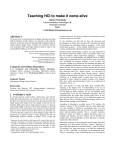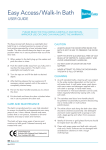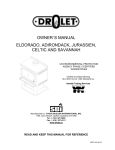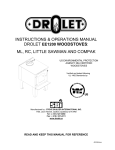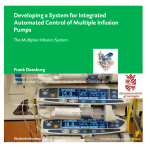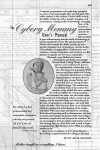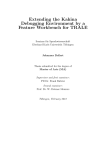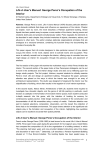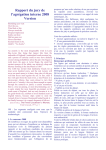Download "user manual"
Transcript
Interaction Design and Architecture(s) Journal - IxD&A, N. 3-4, 2008, pp. 9-16 Teaching HCI to make it come alive Harold Thimbleb y Future Interaction Technology Lab Swansea University Wales h.thimb leb [email protected] Press On [24].) ABSTRACT We review how to teach effectively in higher education (covering both the literature and the author’s own opinions), with particular reference to HCI and using real life-and-death examples, based on simple medical design issues. Students are motivated because even elementary HCI knowledge empowers them to make a real and significant difference in the world. If user interfaces are bad and we have the processes and knowledge to do better, then somehow HCI education has failed the developers (or marketing people or managers…) who create current poor systems — it has certainly failed the users of these systems, and the people affected detrimentally b y them. “When I see how much education can be reformed, I have hope that society may be reformed.” Gottfried Wilhelm Leibniz Questions about understanding a subject are rarely addressed in the literature about that subject. Kline [11] presents many ways that our academic culture undervalues pedagogy — pedagogy being one way of understanding and thinking about a subject. While many organisations have research arms, many universities have essentially no research in-house in one of their core activities: teaching. The instructions for formatting this paper (the ACM computing classification system) gave an explicit list of topics, but they did not expect to classify articles that talk about how any subject is acquired, understood, used or let alone taught; they expected topics like “human factors,” not the topics of thinking about or reflecting about “human factors,” whether teaching, communicating or using it. It’s as if just stating facts are sufficient; as if nobody needs to think about how facts are presented or learnt, whether by readers of papers or by students. (This view will be encountered again, below, as an expression of Ramsden’s Theory 1.) “The main part of intellectual education is not the acquisition of facts but learning how to make facts live.” Oliver Wendell Holmes, Jr. Categories and Subject Descriptors K.3.2 [Computer and Information Science Education]: Computer science education, Curriculum, Information systems education, Literacy. K.7.4 [Professional Ethics]: Codes of good practice. General Terms Management, Design, Human Factors. Keywords Teaching and learning. HCI (human-computer interaction). Human error. Medical device design. Calculators. 1. INTRODUCTION It is obvious that the world could be a better place, and of all the things that need improving, user interfaces are near the top of the list (they’re the top of my list anyway), not least because their bad design makes other things worse: for example, a bad web site user interface might cause users to make expensive errors, or a bad car radio design might so distract a driver from attending to the road that they have an accident. Many user interfaces are bad, and their faults, at least to those who know HCI and can see the faults, are so obvious that they ought to be a point of high leverage where we should invest to improve things. A badly designed web site can detrimentally influence millions of people: it has a huge and invisible social cost. (If you do not believe user interfaces are bad, read on or read Permission to make digital or hard copies of all or part of this work for personal or classroom use is granted without fee provided that copies are not made or distributed for profit or commercial advantage and that copies bear this notice and the full citation on the first page. To copy otherwise, or republish, to post on servers or to redistribute to lists, requires prior specific permission and/or a fee. HCIed, April 2–4, 2008, Rome, Italy. Copyright 2008 ACM 1-58113-000-0/00/0008…$5.00. How then should we teach and think about teaching HCI? Teaching is the highest form of understanding; if we do not understand how to teach, we do not understand our subject. If we are not thinking about teaching, we are not thinking about communicating. Even the most hardened researchers must be concerned about the impact their research papers have; in fact, their research papers must surely aim to teach their readers new ideas and new ways of thinking about their subject. This isn’t so different from wanting to teach students. According to Ramsden’s excellent survey [17], teachers (for instance, teachers of HCI) consider there are three approaches: one, that teaching is telling or transmitting facts; two, that teaching is organising student activity; and, three, that teaching is about making learning possible. That is, teachers (lecturers, professors) adopt an explicit or implicit theoretical stance to teaching and learning, and that teachers can be divided into roughly three classes depending on their approach to teaching, namely these three theories. Many HCI textbooks are encyclopaedias of knowledge about HCI techniques, as if their authors fall into a Theory 1 approach, or into a style that supports an assumed Theory 1 style of teaching. The teacher’s job, using such books, is t o teach the students the facts of HCI, preferably as presented i n the particular book. Theory 1 encourages a style of thinking that every fact must be covered, that it is the teacher’s (or the textbook author’s) job to provide all facts that need teaching. Interaction Design and Architecture(s) Journal - IxD&A, N. 3-4, 2008, pp. 9-16 Fig 1. Imaginary map of all HCI concepts. Fig 2. Forgotten facts can be triangulated from known facts Different subjects and different stages of learning in those subjects call for different approaches. One can imagine that i n an early anatomy or geography course there are indeed a lot of independent facts to learn, but these facts give way to deeper learning if the student progresses. Similarly in HCI, there are indeed many important facts to learn — what is affordance? what is contextual design? what is immersion? — before one can build deeper knowledge and understanding. There are of course many more examples where Theory 1 i s entirely appropriate, most obviously at elementary levels when the student is not expected to have (or want) any understanding of the subject. We have all been there. A student might be taught to “always end a sentence with a full stop.” At school, there may be no room for debate on this fact. Yet when the student becomes a designer, they will discover that posters often have sentences without full stops, and that one can decide not on rigid grammar but on visual criteria, or perhaps on unrelated criteria such as whether your client will pay. In fact, because language is necessarily taught in elementary ways to young learners, many of us have grown up thinking that our use of language is rigidly constrained by what we were taught [4]. We’ve learnt that it’s just non-negotiable rules — unrelated facts. Perhaps this formative learning experience during a major part of our lives, learning our own language, has influenced our approach to all other learning and teaching? Crystal gives the example of the use of commas; they mean different things in sentences. Occasionally, as he shows, their multiple uses may collide, and it ceases to be obvious how t o punctuate — one has to rely on context. We shall see exactly the same problem with user interfaces, in an example used below. And, what is crucial, we see teaching, learning, and HCI all coming together, in commas, of all things! Theory 1 is necessary, but it is not necessarily sufficient. We spent many of our formative years being taught elementary facts, and it is understandable how we end up ourselves being teachers who emphasise facts. If we are not careful, we end u p with students who know some facts, namely, exactly the ones we teach them to pass their courses, but don’t they know how to think for themselves about HCI, and are therefore unable t o apply their knowledge to the work environment they later find themselves in. Ultimately, as students graduate and get jobs, we end up with interactive systems — web sites, ticket machines, voice menus, aircraft, medical equipment — that have bad user interfaces. Or as students graduate and become Fig 3. New discoveries are made by triangulating from the known to the unknown. academics, their views influence how they participate in the academic community: they become referees. The Theory 1 attitude affects referees for research papers and research proposals [22]: a common criticism in HCI refereeing is that some facts were missing (i.e., facts from a different subdomain of HCI that the referee wishes to emphasise), as opposed t o some reasoning was flawed. Ultimately, then, I believe, Theory 1 is not an effective form of teaching for HCI. Indeed, Ramsden makes it very clear that Theory 3 is, for most things, better. An example of Theory 3 teaching comes from Feynman [7], who is widely recognised as one of the most inspiring teachers of physics. Figure 1 shows an imaginary map of all HCI ideas and concepts within a region drawn as a grey blob; figure 2 shows how a student might be able to reconstruct a forgotten fact from several other remembered facts. Probably a student would use some remembered facts, some books, and some experiments: triangulation is somewhat of a simplification t o the idea. (In reality, HCI is so complex that lots of facts would be needed to triangulate, and perhaps the idea might better be called interpolation.) The purpose of teaching a student is so that they are eventually able to construct new knowledge — it would be a sorry state of affairs if they could only ever know less than their teacher! Figure 3 shows how exactly the same triangulation idea works for a student discovering new knowledge. The point is, by teaching a student how to connect ideas together, they are empowered to learn new things, even ideas they were not directly taught. Feynman sees the blobs in these figures as knowledge, as known by everyone. Instead the blobs might be used t o represent the student’s own knowledge. Then, perhaps that star in figure 3 might have been the x my friend missed. Would i t not be more useful for a student to know that x was missing and be able to work it out, than not to think but only know what they were taught from figure 1? William Perry’s study of how students learn suggests that the least sophisticated students, or students at early stages of learning a subject, tend to want to learn true facts [15]. Students at this level thus dovetail their expectations with the teacher’s use of the Theory 1 approach to teaching. Unfortunately, both Theory 1 and Perry’s low end of sophistication interact in a sort-of vicious circle: they support each other, and are ideal for teachers and students with little confidence in the subject. Neither enables the students to g o Interaction Design and Architecture(s) Journal - IxD&A, N. 3-4, 2008, pp. 9-16 beyond the teacher, so the students are limited to exactly what is taught. Students soon will only do work that leads t o assessment. It is but a short step to automating the assessment, with multiple choice, to see exactly what facts that the student has learned: once automated, the student is even denied any flexibility in interpreting the right answers. Teaching, at least as presented by Ramsden, is about getting students to learn and engage with ideas. Correspondingly, we can consider that HCI is concerned with getting users to learn and engage with ideas about, in this case, complex interactive systems. It’s the same thing. Research in HCI, such as Carroll’s classic work on “minimalism” [3], suggests that users are best helped when instruction follows four principles: 1 Choose an action-oriented approach; provide immediate opportunity to act; 2 Anchor the ideas in a task domain; select real tasks; 3 Support error recognition and recovery; prevent mistakes where possible; 4 Support reading to do, study and locate; be brief — don’t spell out everything. Of course Carroll elaborates these principles further, but it i s interesting to note that even from this summary, it is clear that Carroll’s principle 4 manages to simultaneously contradict Theory 1 teaching and support Theory 3 teaching. HCI itself, then, suggests that teaching HCI should provide an immediate opportunity to act, based on real tasks, should prevent mistakes, and be brief. Kline suggests that the worst sort of teaching just presents unmotivated facts [11]; the facts may be motivated for the teacher, but to the student they seem pointless. Or take Carroll’s point 3, above, that suggests that students might learn by making mistakes and learning from them. Theory 1 does not do well from Carroll’s perspective. It is hard for a student to make a mistake when their teacher adopts Theory 1 and for them not to be simply wrong; there is n o incentive to learn from mistakes. Worse, as Theory 1 approach leads to simple assessment, it’s likely that the only feedback students get on their understanding is when they are formally assessed: a significant disincentive to make mistakes or even explore around the subject. Why would a learner make experiment, possibly making mistakes, when doing s o guarantees getting fewer marks? As Ong has suggested [14], ever since the invention of the alphabet (one of the earliest technologies) we have taken it for granted that knowledge can be written down. If it can be written down, we can teach what is written. But that is Theory 1. Rather, ask why do we lecture if we have books? The answer is that we should not teach facts: that encourages shallow learning. Instead, we need to motivate, make accessible, enthuse. Just as Carroll’s work suggests, we need to get students engaged with real tasks as quickly as possible. Why do students go to lectures when they could read books or read off the web? Somehow the interaction and excitement of the lecturer is supposed to rub off in a way that the textualised book or web page does not permit. Teaching is performance, not instilling facts. Books, web sites, computerised teaching tools as an end in themselves turn teaching into dead text. How do we get students into real activities? How can we d o that when, at least at the beginning, they do not know enough HCI to reason or apply what they know: they don’t know enough. Well, actually, they do: we can ramp them up. 2. PERSONAL VALUES We, whether students or teachers, are all different and we all have different perspectives to bring to the teaching and learning forum. As teachers, we have had formative experiences as students ourselves, and sometimes we emphasise personal values rather than ones supported by good pedagogy. I am n o exception. Of Ramsden’s theories, then, I lean towards Theory 3, but that isn’t everything. Here are some further factors, emphases, I consider very important — but I offer no scholarship to back up my prejudices, only my own limited experience. My experience, as is obvious, influences the experience of my students and even the students who choose to come on my courses. This biased sampling will reinforce my prejudices, even when they are misleading me. Indeed, I know that not everybody agrees with me; these are my values, not my unqualified recommendations. Teaching and learning is fun. If people are not enjoying what they are doing, this in itself is demotivating. If students enjoy their work, they will do it better, they will be more committed to working on it, working hard, and thinking deeply about it. And work that a student has done that they have enjoyed will be more enjoyable to mark. Teaching and learning is fire. It’s not just fun, it’s serious fun: fire in our hearts, fire that spreads, fire that lights the imagination. It’s about things we feel strongly about — nothing luke warm. By teaching we light up many students and are more effective than in ordinary jobs where we would have no such leverage. In each class we want to inspire especially those students who are sparked by the subject and are going to carry the flames forward. (Later in this article, I present some ideas that fire me up.) Teaching and learning is exploration. I know the terrain, but I want students to find things out for themselves, and even find out things I don’t know. Because my lectures are interactive, I was once told the students like leading me down garden paths. The students think they are distracting me; but I know we are exploring the HCI issues of what they are interested in. Teaching and learning is research. The students can find out things, test ideas, and find out things none of us knew to start with. The problem with this style of teaching is that it is hard to predetermine outcomes; it is certainly nearly impossible t o provide notes beforehand. (But notes fall into the Theory 1 view.) This stance makes it particularly difficult to support students with certain needs, such as dyslexics, who benefit from more prepared material and (for example) material presented in different media. Teaching and learning is formative. The students want feedback from me about their achievements; I want feedback from them about my teaching — and both of us want i t formatively, not at the end of the course. I believe I can d o better, and I encourage students to give me feedback, to point out mistakes or things they like. Indeed, as Carroll [3] wanted with user training, if students can recognise my mistakes, I am lifting them from passive learning to active participation. By discussing mistakes in lectures, they are learning much more useful attitudes and skills. Interaction Design and Architecture(s) Journal - IxD&A, N. 3-4, 2008, pp. 9-16 Teaching and learning is open. There are many horrible arguments for being secretive about teaching and learning. Failure is private. Success causes envy. People may steal my good ideas. It surprises me how rarely teachers share insights into each others’ work — even if they know about it. I feel I am intruding when I go to other lecturer’s classes! (And n o colleague has been to one of my own classes for a long time.) I am increasingly assessing students in open ways: for example, asking them to do coursework as posters, not essays. Then an afternoon’s “conference” can both have me marking the coursework (and interacting helpfully with the students at the same time), as the system requires, but more importantly each student sees the quality of each other student’s work. They learn by my creating open processes. Teaching and learning is reflective. I teach how I teach and why I choose particular approaches, and I teach how students may learn better, and I do this within the HCI course. We all then engage consciously with the teaching and learning process, and renegotiate changes each time I teach. I encourage students to think explicitly about how they want to be successful. Teaching and learning are paradoxical. I have learnt many complex things, like speaking and walking without anybody really trying to teach me; and I’m glad I learnt these things before school. School “taught” me lots of things I have not, i n the end, learnt, and it put me off many other things, like speaking French. Conversely, I have taught many complex things by not trying to teach at all. My children know how t o solder, but I didn’t teach them in any way a university would recognise, with notes, assessments or learning outcomes; i t was a lot easier than that, and they never said they’d only comply if I marked them. Less is more. I could extend this list indefinitely, but less i s more. You, the reader, must surely have started to have ideas about teaching and learning (you don’t have to agree with me), and if I carry on with my ideas you will lose your own ideas. The last point, less is more, applies recursively. If as teachers we put more effort in to teaching — writing more detailed notes, say — the more we do the less we leave for the students, and the less we leave for the lecturing to unfold in the dynamic relationship we create with the students. Then, the less the students own of what we teach. Teaching and learning don’t stop. There’s always more. I want at least some of my students to learn more than I know. One consequence of this view is that, where possible, I use coursework rather than examinations. With exams, there is a fixed syllabus represented by the questions, and at some stage you have to start playing games with the students: in a revision class, for instance, you can’t really tell them the answers to the questions you’ve set. You then get into complex political games, which are made worse by “marking schemes” and other devices. With coursework (portfolios and other techniques) you as a teacher always want the students t o do as well as possible, and there is no need to hold back o n telling the answers — you want the students to know, so they can go beyond them. Conversely, the students don’t ask, “do we need to learn this for the exams?” as anything and everything you teach can help in their coursework (and, later, in their real world work) — there are virtually no exams in the real world, so why teach to them? 3. LIFE & DEATH EXAMPLES IN HCI I want to teach an important subject where students can identify with the problems, and feel that they can recognise the faults and start to see solutions that they could be part of. HCI is ideal for this sort of teaching. It is ideal for interactive lectures that involve students; it is ideal for encouraging students to bring gadgets that they are frustrated with, and then to enable them to see how the principles of HCI can g o beyond problems to solutions. Some students will go on t o work where they can influence future design. All of the students graduating from an HCI course will have some influence on design decisions; they will know about user centred design, individual differences, etc, and they will influence others to do better. Imagine a picture of a patient in an intensive care unit in a hospital — in the lecture environment, this could be a picture displayed for the class to see. Imagine, then, the patient i s surrounded by gadgets: ventilator, syringe pumps, and so on. Even the bed they are lying on has numerous buttons. Who i n the class has been in intensive care, perhaps to see a relative? Don’t we want those gadgets to be safe and easy to use? Interactive medical devices are safety-critical devices whose correct operation is essential. Errors in their design or use can lead to medical incidents, including death. Medical error is a major problem, though not widely recognised. In paediatrics, a study showed that 55% of patients received incorrect drug doses, approximately 10% of which were potential adverse events [10]. The problems are not just technical, or problems associated with using complex devices (that, for example, might be solved by better training); in studies, 58% of nurses make calculation errors when doing relatively simple drug dosage calculations [19]; alarming comments such as “The potential for serious clinical errors caused by faulty calculation of dosage by house staff officers is high” [16] are routine in the literature. The UK Medicines and Healthcare products Regulatory Agency’s safety guidance says “an increasing number of incidents that result in significant morbidity or mortality arise out of user/device interface problems or because of poor practices” [13]. The problems are exacerbated by poor and over-complex device design — bad HCI. Clinicians accept as routine using workarounds, such as switching off and o n devices to recover from errors — often losing data (e.g., body weight) in doing so. Indeed, there are many near misses that are not reported as design problems because they do not lead t o adverse clinical incidents. Around 10% of hospital intravenous pump uses have errors, and 1% have serious outcomes [8]. HCI will have a significant impact, then, particularly with the substantial skills and background that I bring to the area. Medical errors are in fact worse than AIDS, car accidents and other high-profile social problems [6], by a factor of over two: they are under-reported partly because of litigation problems, and also partly because medical errors are typically resolved through private settlement. “Near misses” are not reported, because clinicians do not recognise device design problems as such, and because near misses have no clinical consequences that need to be reported. Often, too the operator (such as the responsible nurse) is blamed, or their training and management is blamed. Thus the root causes of the medical incident — which includes technology problems — are not Interaction Design and Architecture(s) Journal - IxD&A, N. 3-4, 2008, pp. 9-16 properly addressed. Moreover, incident investigations after an adverse clinical incident often ignore technical factors; if a device “operates as designed” it is taken to be correct, and problems in its use are then supposed to be due to operator problems, even if those operator problems may (to us) be a symptom of bad design! As a case in point, in a commissioned human factors study of a clinical procedure, numerous human factors problems with an infusion pump were identified, but rather than criticise the device design, however, the conclusion drawn was that hospitals should perform human factors studies and better train nurses to conform to the device design requirements [9]. From HCI (e.g., as codified in ISO13047, for instance) this i s exactly the wrong way around: device design should be based on a clear understanding of the user’s tasks and behaviour. The student can see that what they are learning could change the world. Of course, there are also hospital management and operator problems [e.g., 2] and better teaching can improve performance [e.g., 5], whether or not device design is improved: each should be considered a defense, in the sense of Reason [18], and hence part of proper professional clinical practice. What seems beyond the reach of clinical practice, however, is t o improve the HCI. There are numerous problems with device design, particularly computational issues (such as drug dosage calculation: see example below), and you want students to identify with these problems and see that they could really make a difference. The medical community is not thinking about these issues; our HCI students could be the ones to improve health! Tell a story … consider a cancer nurse asked to program an infusion pump for a patient requiring a dose of the chemotherapy drug fluorouracil. The nurse goes to the hospital pharmacy with the order, and returns with a labelled bag of diluted fluorouracil. The nurse’s task is now t o calculate from the pharmacy data a dose in millilitres per hour to programme an infusion pump to deliver that dose rate over the coming four days. The relevant numbers and units are 5250mg of fluorouracil diluted to 45.57mg/mL, and to be delivered over 4 days. Because the infusion pump uses units of mL/hr, the nurse must calculate 5250/45.57 as the volume to be delivered, and at an appropriate rate for over 24×4 hours. They would do a calculation as follows: 5250 (4 × 24) 45.57 This calculation will be done by the nurse using a calculator, and will be checked by a second nurse as a precaution. If using a calculator, the nurse must convert the calculation into a sequence of operations (button presses or mouse clicks, if it i s € calculator) to perform this calculation. For a PC-based example, AC 5250 ÷ 45.57 ÷ (4×24) = will obtain the correct result 1.2. However, we can imagine it likely that the nurse does not have a calculator with brackets available, and instead they should do AC 5250 ÷ 45.57 ÷ 4 ÷ 24 =. One wonders what nurse knows that dividing by a product is equivalent t o repeated division (and note that the term 4 ÷ 24 in the sequence of operations does not calculate the quotient 4/24); far more likely, then, that the nurse will calculate 4×24 either on paper or use the calculator and store the result in the calculator’s memory. One would then anticipate doing AC 5250 ÷ 45.57 ÷ MRC = to get the right answer. This is all familiar work, but it is showing how “simple” interaction is in fact much more complex once it is analysed. We could digress into task/action maps, GOMS and other areas. In this example, 4×24 is perhaps easy enough to do mentally or perhaps the nurse can remember 96 without using the calculator’s memory, but in general a drug dose calculation (e.g., a pharmacy dilution) will be harder than these figures suggest — and in any case it is wise to independently doublecheck with a calculator. How then can we work out 4×24 and store it in memory? A typical basic calculator like the Casio HS8V has a memory. Like many such calculators it does not have a single store-in-memory key; it has an add-to-memory key instead. In order to store a number to memory, then, the memory must first be set to zero, otherwise the number stored will be undefined. If the nurse starts to calculate 4×24 before zeroing the memory, it is essentially impossible to store the result correctly. In fact, to be correct, the nurse must do the following sequence of operations: AC MRC MRC 4 × 2 4 MPLUS 5250 ÷ 45.57 ÷ MRC =. The button MRC must be pressed twice, and on some calculators, AC must be pressed more than once. In computer science terms what the nurse has just done i s called compiling [e.g., 1]; the nurse has compiled a formula into a sequence of machine code operations (button presses) t o execute the calculation. To compile correctly, the semantics of the target machine (here, the calculator) must be known; but unfortunately there are no published calculator semantics t o help — and we know many calculators are very different (and, worse, mathematically wrong) despite even looking alike [21]. Clearly compiling is a non-trivial task for a user, and indeed one can imagine it is especially difficult for people trained as nurses rather than as computer scientists. Conventional calculators have numerous usability problems, some due to their ergonomics, some due to their programming, and some due to “feature interaction” — inevitable problems due to their design. The small size of typical LCD displays creates ergonomic problems: users may misread results, for example confusing 4 and 9 (which may be indistinguishable if the top segment of a 7 segment display is not visible to the user). If incorrect buttons are pressed (e.g., – instead of +) there will be no error, just the wrong result. The user can typically only see the result and not the formula that leads to it; worse, if the = button is not pressed, the LCD will be incorrect. Examples of feature interaction include the multiple roles of operators. Users may make mistakes, so multiple operator use may retain only the last used operator: operators are then both mathematical operators and editing operators. Thus ×– would be treated as (edited to) –. This makes performing a calculation like 4×–5 difficult (this is a simple example to show the nature of the problem) because it is evaluated as 4–5; unless the user knows the ± key, or is able to transform 4×–5 into a different calculation, such as 4×5 and then mentally change sign, the feature interaction is deeply confusing. Here, we have got a problem redolent of commas: the user’s actions, pressing buttons, means different things even though they are pressing the same buttons. The first press defines just a mathematical operator; the second press is also a correction. Interaction Design and Architecture(s) Journal - IxD&A, N. 3-4, 2008, pp. 9-16 The designers wanted to permit correction, but by doing s o they implicitly forbade a user being able to enter sequences of operators. Perhaps they thought that – – really means + s o should never be used, but they forgot that ×– does mean something more interesting than –. Worse, when we look at the frequency of use, these situations arise so rarely that users will not know what is going on; they won’t be familiar with the complex semantics. Typically, they will simply want to d o sums, not experiment and learn how to use the calculator. Indeed, people use calculators because they do not know the correct result, so they may think the answer (in the example) really is –1 instead of –20, believing the calculator is correct; it usually is. There is a similar problem with the decimal point (a frequent factor in dosage errors). Entering 3.2.1 on a calculator generally gets 32.1, but on the Graseby 3400, a medical device, although the user manual says “it works like a calculator,” entering 3.2.1 gets 3.1 — losing the 2, and reporting no error to the user. Each decimal point on this medical device is taken to zero the decimal part of any number being entered (hence the intermediate step 3.2. gets 3.0, silently) — with final results differing by more than a factor of ten compared to a calculator. Whereas on a calculator, entering decimal points loses n o digits, but starts the decimal part of the number. Despite the manual saying they are the same, in fact the two approaches are completely different ways to handle the ambiguity of the dot meaning two different things. It’s the comma problem again i n another guise. We do not know whether this difference matters clinically, but it seems very sloppy that user manuals are misleading. We need to do experiments to find out. Our students need to do experiments to find out. Students, however, assume that calculators “just work” and therefore they are not objects of serious study as such: it’s Perry’s early levels again — there is a right and wrong way of using calculators and students should know the right way (Ramsden’s Theory 1 again). But at higher levels of intellectual sophistication in Perry’s levels, the students see that “the right way” is a naïve view of HCI. The example shows that interacting with a calculator is nontrivial, induces latent errors, yet is amenable to computer science (here, compiling). In fact, the example above was based very closely on a real case, where a patient died in 2006 as a result of the above calculation having an error in the execution of the 4×24 step [9]. Students can obtain this report, or find other similar reports on the internet [e.g., 20], and critique them. As this example came from a real case, it is interesting to look at the interactive device involved in the fatal incident. The infusion pump itself was an Abbott AIM Plus. In the mode where the nurse should enter mL/hr, the display option i s incorrectly shown as mL; moreover, the HELP button provides information on 2 out of 3 options — which does not include the incorrectly labeled mL (mL/hr) option! The pharmacy computer printed the label on the fluorouracil bag, including many numbers 1.2mL/hr, 28.8, 50, etc. Both nurses incorrectly calculated 28.8 (i.e., a factor of 24 too high), yet this incorrect number had been calculated by the pharmacy, presumably i n case the infusion pump in use was calibrated in mL/day. The label would have provided confirmation bias for the nurses and reduced their attention to relevant detail; indeed, the cognitive load of compiling a complex calculation would have reduced their vigilance generally. The analysis of this incident [9] performed a human factors study of the Abbott pump. Five chemotherapy nurses worked through a scenario similar to the actual incident. All five nurses had significant problems, including repeating the errors that led to the fatality. It took the analysis maybe an afternoon to establish that nurses had problems. What should one conclude? That nurses should be better trained? That hospitals should do more careful procurement? That designers should do human factors studies before releasing products? All of these! What should one conclude? That HCI understanding is missing from the entire process, from the earliest concept, even to the final report after the something has gone dreadfully wrong. The Abbott AIM does do some things that are recommended b y good HCI practice. For example, it provides dose reviews. We can imagine that the designer was taught in their HCI course that validation is important, so the AIM validates the numbers the user entered. If the user enters 28.8, later the device says (not in so many words) “is 28.8 what you really meant?” Unfortunately that is merely recycling a simple HCI fact in the design, not thinking it through. The report [9] criticises the design for merely reviewing numbers entered rather than numbers calculated from them; that is, the Abbott confirmed the nurse had entered 28.8 — which is what the nurse mistakenly intended to enter, s o telling them what they wanted and expected is not very good validation — but if it had calculated that at this rate the volume of drug to be infused (which the pump knows) would be consumed in four hours, the nurse would most probably have been alarmed as the infusion should have lasted four days (96 hours). The way the AIM pump is currently designed, it does not make the user think. The user entered 28.8. Did you mean to enter 28.8? Isn’t that just what I said? Of course, I said 28.8. Yes. The device has engaged with the user at a Theory 1 level. What fact did you teach me? Please confirm. Nobody thinks. Nobody realises that the facts can be triangulated t o new facts. In this case, the AIM pump had several facts — such as the rate of drug delivery and the volume of the drug available. A simple triangulation could calculate that it will only run for four hours. The nurse (we presume) knows it is for four days, but the device never asked if anything made sense. These examples show that calculations and calculators are very problematic in the medical domain. The examples also suggest that proper attention to easily taught HCI principles could have an enormous and very worthwhile impact on the world. Conversely it is obvious that awareness in the medical profession and the medical device industry of the potential for improvement is very limited; the incident analyses cited above ignore these issues. Reports suggest clinicians should be better trained to use the devices; yet the standard view i n usability is that the devices should be designed to fit the users’ tasks. It is easier (and cheaper) to blame operators and/or their training than question the whole culture of interactive systems technology! Why aren’t devices made simpler and consistent with clinical practice so that operator training becomes simpler, rather than the other way around? What are our students going to do? Can calculators be made better? Will Thimbleby shows a prototype calculator that appears to make dosage calculations a lot easier [25]. There are many reasons why the calculator i s Interaction Design and Architecture(s) Journal - IxD&A, N. 3-4, 2008, pp. 9-16 good [23], but students should be encouraged to try using it, and to devise experiments to determine whether our intuitions about its usability survive the rigors of the laboratory. One might also do experiments with nurses, as they are likely t o have weaker arithmetic skills than HCI students. Here is a real screen-shot of the calculation example shown above taken directly from our prototype calculator: potential value; won’t it be motivating for the student to know their work, even as sketchy, has value? Since current clinical papers do not explore the HCI at all, strictly we are at present unable to say whether incidents are partly or fully caused by bad HCI. Certainly, there i s considerable scope for student projects, particularly if any students know of any friendly nurses who they can interview. Soon our students will be writing projects, then writing papers, then engaging with the HCI and user communities — and starting to change the world. 4. CONCLUSIONS All text was hand-written, but then morphed in a typeset font. Note that the user has failed to provide a closing bracket “)” and this has been supplied automatically, along with the correct answer 1.2. The calculator reduces the size of the decimal part of numbers, as this improves readability. The calculator is based on sophisticated computer science: a 2D parser/compiler, a numerical constraint satisfier, a nonproprietary (cross-platform) maths handwriting recogniser, and graphical animation. The calculator also has many more smoothly-interacting features we do not describe here, including complex exponents, radicals, font scaling, a direct manipulation memory and repository of equations, etc. It is easy to imagine a student project might develop this calculator to make calculations more reliable. Below is a very simple possibility (drawn in a graphics program) that would be displayed on an LCD in colour so the nurse’s data and the 1.2 mL/hr answer are clearly highlighted: Notice how the calculator “knows” that days have 24 hours, thus avoiding at least one source of error. As the nurse writes the values 5250 etc, confirmational sound or voice feedback can be provided; the highlighting circle might have a varying visual texture to make it salient. Different layouts and semantic constraints (e.g., type checking) need to be evaluated in use for their effectiveness. Ideally, the calculator would handshake the rate and the units with the infusion pump using Bluetooth or IRDA, then confirm with the nurse, thus avoiding the possibility of further keying error on the device — or, of course, the calculator could be in the device. Further, if the calculator can communicate with the pharmacy (and/or the EPR, electronic patient record), then all figures on the display shown above can either be automatically provided — hence correct — or they can simply be confirmed (in some straight forward interaction) by the nurse, rather than entered, thus avoiding typing/writing errors. There are many possibilities; usability experiments will find, evaluate and refine them. The picture is just that: a picture that is no more than a paper prototype, yet it stimulates thinking. We know that using conventional calculation/calculators, nurses use the wrong dosage formula 29.5% of the time [12]; this is a source of error that should be fixable in the same way, or similar ways, t o those illustrated above. Even such a simple sketch has great A proper concern of any subject is how people learn that subject, for if they do not learn it successfully, then the subject fails — certainly the academic community fails. If the subject is too complex, obfuscated, uninteresting, dead, then i t becomes at best the isolated thinking of the few. In any subject with practical application, such as HCI, the subject needs to be successful in the world: it needs practitioners who understand and can apply the subject in order to make use of it. We therefore have to focus on pedagogy as a proper part of the discipline. How do we teach HCI? My answer is to enthuse students with the enormous impact HCI can make to the quality of life around them. In this article, we looked at life-and-death stories about medical devices because, considered as examples in HCI, they are in fact relatively simple and uncluttered compared t o examples based on, say, consumer devices such as mobile phones (with integrated music players, cameras, web browsers, etc). It’s also clear in this domain that the HCI answers are not a matter of learning facts and answering questions. There i s debate to be had, and students can get into it and start thinking, doing experiments, and triangulating new ideas from what they are learning. From the compelling examples shown briefly in this paper (in section 3), it is easy to show students that they are starting to learn important, life and death things that the world needs to know and to apply. Some of them may go on to have a role in that in their professional careers. Moreover, HCI is concerned with how people learn to use complex systems effectively, and many issues in HCI can also be presented as reflections on how HCI itself is taught; HCI i s a complex system of sorts, and students are users of sorts. Am I teaching HCI in a way that is compatible with what I am teaching about good HCI practice? If, as I’ve suggested, HCI is a subject with a crucial role i n quality of life, then we should take it seriously. It amazes me that taking things seriously — particularly in higher education — often leads to us making things private and unexciting. On the contrary, HCI begs to be public and exciting. Why do we hide academic results (and get bored) but get excited over football games, where success and failure are public? People strive to get better when they get excited, and frankly most students fail to work out how to get excited over anything that is as private and secretive as conventional education has become. As teachers we have a pleasurable duty to work out with our students what is exciting. HCI is indeed a life and death subject that is everywhere, even in the classroom. Even when the projector doesn’t work, perhaps especially when the teacher despairs with the projector’s terrible HCI, then HCI becomes relevant and alive to the students. Interaction Design and Architecture(s) Journal - IxD&A, N. 3-4, 2008, pp. 9-16 5. ACKNOWLEDGMENTS Just as teaching gets better when students engage with the teacher, this paper is far better than it would have been because some of its early readers took the trouble to engage with its author. Alan Blackwell (Cambridge University), Paul Cairns (University of York), and Tony Hoare (Microsoft), each made extremely valuable comments, indeed valuable criticisms, for which I am very grateful. 6. REFERENCES [1] Appel, A. W. & Palsberg, J. 2002. Modern compiler implementation in Java, Cambridge University Press. [2] Brennan, T. A., Leape, L. L., Laird, N. M., Hebert, L., Localio, A. R., Lawthers, A. G., Newhouse, J. P., Weiler, P. C. & Hiatt, H. H. 1991. “Incidence of adverse events and negligence in hospitalized patients.” Results of the Harvard Medical Practice Study I, New England Journal of Medicine, 324:377–84. [3] Carroll, J. M. ed., 1998. Minimalism: Beyond the Nurnberg Funnel, MIT Press. [4] Crystal, D. 2006. The fight for English, Oxford University Press. [5] Degnan, B. A., Murray, L. J., Dunling, C. P., Whittlestone, K. D., Standley, T. D. A., Gupta, A. K. & Wheeler, D. W. 2006. “The effect of additional teaching on medical students’ drug administration skills in a simulated emergency scenario,” Anaesthesia, 61(12):1155-1160. [6] Department of Health, UK, 2003. Design for patient safety. [7] Feynman, R. P., Gottlieb, M. A. & Leighton, R. 2006. Feynman’s tips on physics, Addison-Wesley. [8] Husch M., Sullivan C., Rooney D., Barnard C., Fotis M., Clarke J., Noskin G., 2005. Insights for the sharp end of intravenous medication errors: implications for infusion pump technology, Quality and Safety in Health Care, 14:80-86. [9] ISMP, Institute for Safe Medication Practices, Canada, 2007. Fluorouracial Incident Root Cause Analysis. http://www.ismp-canada.org [10] Kaushal, R., Bates, D. W., Landrigan, C., McKenna, K. J., Clapp, M. D., Federico, F., Goldmann, D. A. (2001) “Medication Errors and Adverse Drug Events in Pediatric [11] [12] [13] [14] [15] [16] [17] [18] [19] [20] [21] [22] [23] [24] [25] Patients,” Journal of the American Medical Association, 285(16):2114-2120. Kline, M. 1977. Why the professor can’t teach, St Martin’s Press. Lesar, T. S. 1998. “Errors in the use of medication dosage equations,” Archives of Pediatrics & Adolescent Medicine, 152:340-344. MHRA, UK Medicines and Healthcare products Regulatory Agency, 2006. One Liners. Ong, W. 1982. Orality and literacy: the technologizing of the word, Methuen. Perry, W. G. 1999. Forms of ethical and intellectual development in the college years, Jossey-Bass. Potts, M. J. & Phelan, K. W. 1996. “Deficiencies in calculation and applied mathematics skills in pediatrics among primary care interns,” Archives of Pediatrics & Adolescent Medicine, 150(7):748-752. Ramsden, P. 2003. Learning to teach in higher education, 2nd ed., RoutledgeFarmer, 2003. Reason, J. 1990. Human Error, Cambridge University Press. Santamaria, N., Norris, H., Clayton, L. & Scott, D., 1996. “Drug Dosage Calculation Abilities of Graduate Nurses,” Joint ERA-AARE Conference. Scottish Executive, 2006. Unintended overexposure of patient Lisa Norris during radiotherapy treatment at the Beatson Oncology Centre, Glasgow in January 2006. Thimbleby, H. 2000. “Calculators are Needlessly Bad,” International Journal of Human-Computer Studies, 52(6):1031-1069. Thimbleby, H. 2004. “Supporting Diverse HCI Research,” Proceedings BCS HCI Conference, 2, edited by A. Dearden and L. Watts, Research Press International, pp125-128. Thimbleby, H. 2006. “Applying Bohm’s ideas in the age of intelligent environments,” International Symposium on Intelligent Environments, pp27-33. Thimbleby, H. 2007. Press on: Principles of interaction programming, MIT Press. Thimbleby, W. 2004. “A Novel Pen-Based Calculator and Its Evaluation,” Proceedings of the third Nordic conference on Human-Computer Interaction, pp445448.








